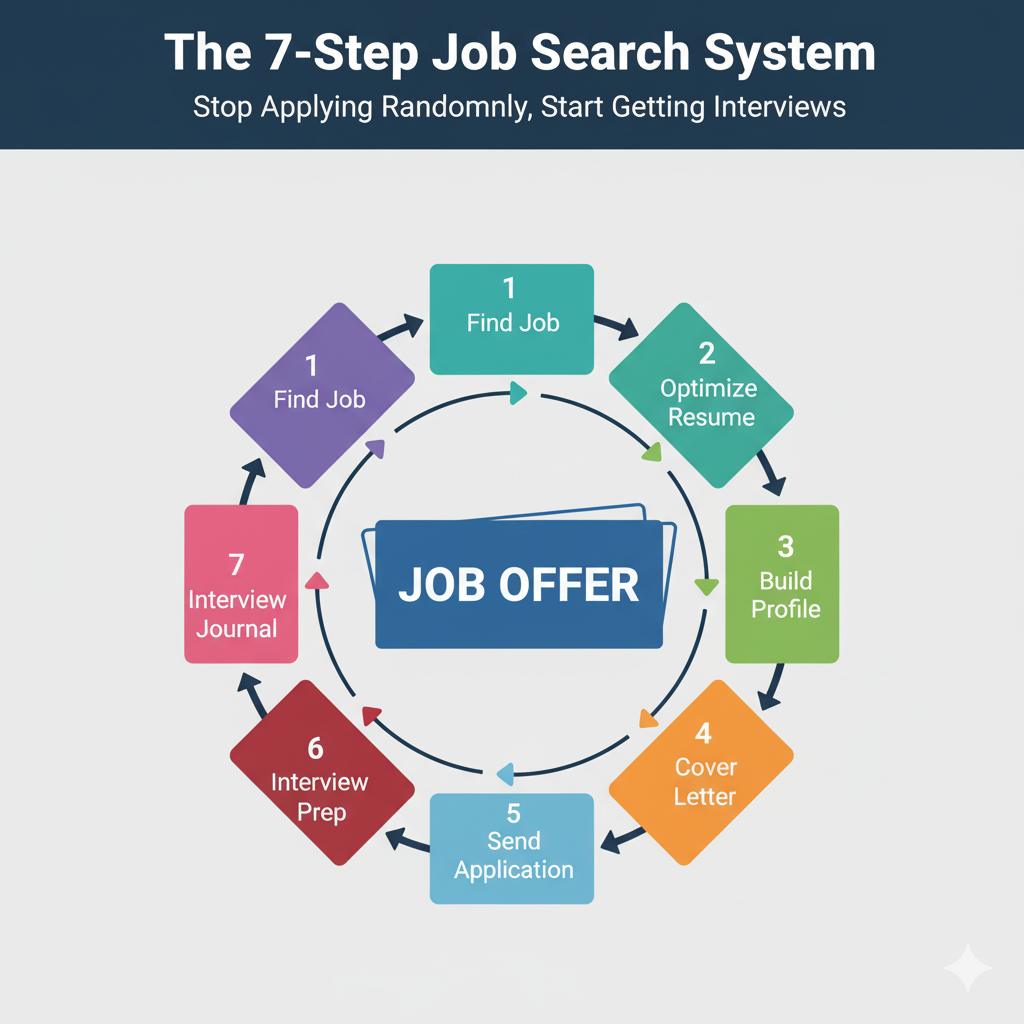
Complete 7-step job search workflow system diagram from finding jobs to landing offers
The Complete 7-Step Job Search System That Actually Works
You've been applying to jobs for weeks. Maybe months. You've sent out dozens of applications - maybe even hundreds. But you're not getting interviews.
Here's the problem: you're treating job searching like a lottery. Apply to everything, hope something sticks.
That approach doesn't work.
The data is clear: The average job seeker who applies to 50+ jobs randomly gets fewer interviews than the job seeker who applies to 10-15 jobs systematically.
Why? Because hiring managers can tell when you're spray-and-pray applying. Your generic resume, copy-pasted cover letter, and lack of preparation show through.
The solution? Treat finding a job like a job itself.
In this guide, you'll learn the exact 7-step system I've used to help over 150 people land jobs - and the same system I used personally when I was job searching. This isn't theory. This is a proven workflow that works for software engineers, trades workers, recent graduates, and career changers alike.
Why Most Job Search Approaches Fail
Before we dive into what works, let's talk about what doesn't:
The Random Application Method (Doesn't Work)
- See job on LinkedIn
- Send same resume to everyone
- Never follow up
- Wonder why no one responds
- Repeat 100 times
Success rate: 1-3% interview rate
The "Perfect Resume" Obsession (Doesn't Work)
- Spend weeks perfecting one resume
- Design a beautiful template
- Never actually apply to jobs
- When you finally apply, ATS rejects your fancy format
Success rate: 0% (because you never actually apply)
The Volume Approach (Barely Works)
- Apply to 10+ jobs per day
- Don't customize anything
- Hope sheer numbers work in your favor
- Get a few interviews from luck alone
Success rate: 2-5% interview rate (but you're exhausted)
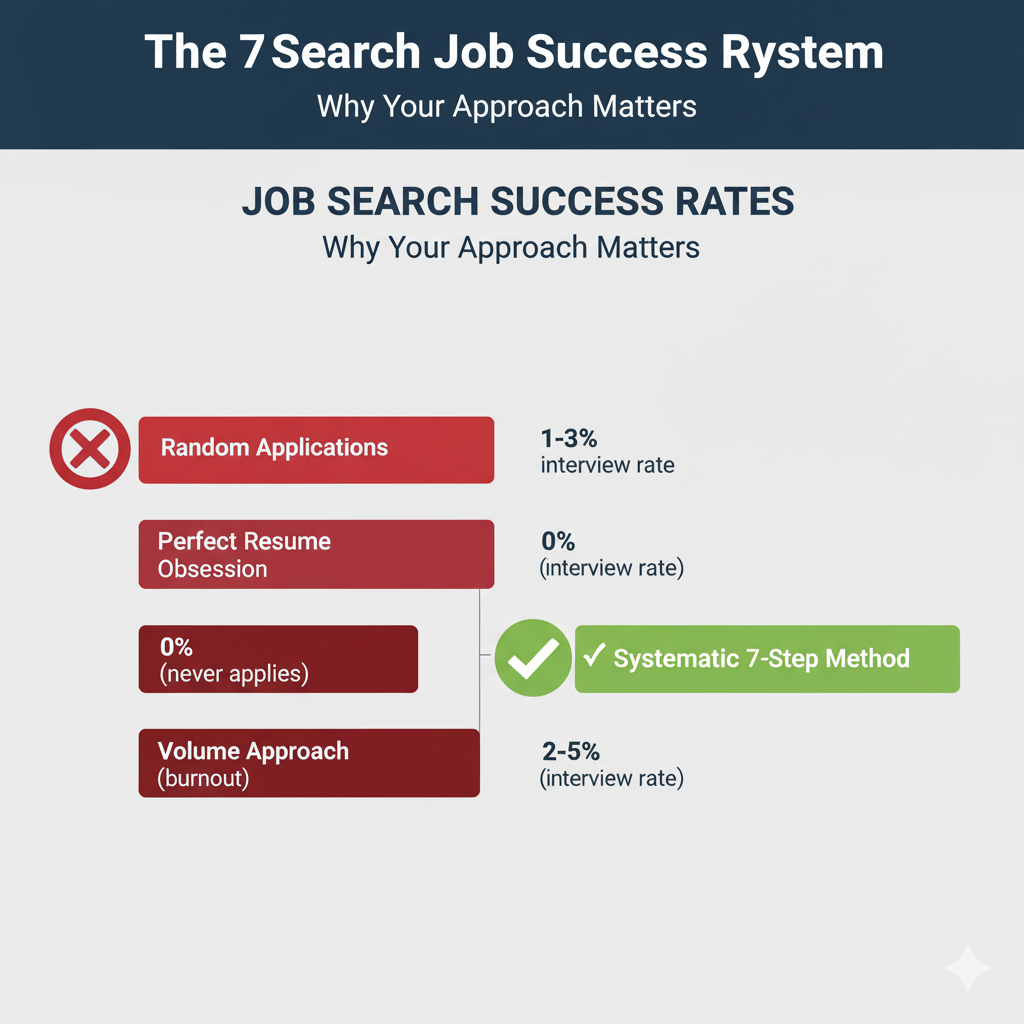
The System That Actually Works
Here's what successful job seekers do differently: They follow a system.
Every job application goes through the same 7-step workflow. Nothing is random. Nothing falls through the cracks.
The result? 15-30% interview rate. That means for every 10 quality applications you submit following this system, you get 1-3 interviews.
Let's break down each step.
Step 1: Find the Right Opportunities (Not Just Any Job)
Most people start by mass-applying. That's backwards.
The right approach: Be selective from the start.
What Makes a Good Opportunity?
Before you even think about applying, evaluate if this job is worth your time:
✓ Check if you meet 60-70% of requirements If the job requires 5+ years and you have 3, that's fine. If it requires Python and you've never touched code, skip it.
✓ Company culture aligns with your values Remote vs. office? Startup chaos vs. corporate structure? Don't apply to companies where you'd be miserable.
✓ Salary range matches your needs If they're offering $60K and you need $80K, you're wasting everyone's time.
✓ Role has growth potential Is this a dead-end job or a stepping stone to where you want to be in 3-5 years?
How to Find Quality Opportunities
Sources that work:
- Company career pages (bypass job board competition)
- LinkedIn job search (set specific filters)
- Industry-specific job boards (not just Indeed/Monster)
- Your network (ask for referrals)
- Company "About" pages (find hiring managers directly)
What to save for each opportunity:
- Job title and company
- Full job description (companies edit/remove postings)
- Job URL
- Application deadline (if listed)
- How you found it (for tracking)
- Hiring manager name (if you can find it on LinkedIn)
Tool recommendation: Use a platform like Hiir.me to save opportunities in one place. When you paste a job URL, AI can automatically parse the job description, requirements, and company info so you don't have to manually copy everything.
Step 2: Optimize Your Resume for THIS Specific Job
Here's the truth most career coaches won't tell you: Your resume isn't good or bad. It's either relevant or irrelevant to the specific job you're applying to.
The same resume that gets you an interview at Company A gets you rejected at Company B - even for similar roles.
The ApplyScore Method
Before you even start customizing, you need to know: How well does your current resume match this job?
Run your resume through an ATS checker (like ApplyScore on Hiir.me) to see:
- Your match percentage (aim for 75%+)
- Missing keywords
- What needs to be added or emphasized
Example:
Job Requires: 5+ years Python, AWS experience, team leadership
Your Resume Says: “Extensive programming background, managed projects”
ApplyScore: 45% Match
Missing:
- Python (mentioned 0 times)
- AWS (mentioned 0 times)
- Leadership not quantified
How to Increase Your Match Score
Add missing keywords naturally: Don't just stuff keywords. Add them in context:
❌ "Python Python Python AWS AWS team leadership" ✓ "Led team of 5 engineers using Python and AWS to build scalable applications"
Quantify everything: ❌ "Managed team and improved performance" ✓ "Led team of 8 engineers, increasing deployment frequency by 40%"
Reorder bullet points: Put the most relevant experiences at the top of each role. If this job emphasizes Python but your current resume leads with Java projects, reorder.
Use their language: If the job says "stakeholder management," don't say "client relations." Use their exact terminology.
Step 3: Build a Tailored Profile (The Modular Approach)
Here's where most people get stuck: "I need to rewrite my entire resume for every job."
No, you don't.
The Modular Resume System
Instead of maintaining 10 different resume versions, create reusable components once and assemble them differently for each job.
Components to create:
1. Professional Summaries (3-5 variations)
- Technical focus (for engineering roles)
- Leadership focus (for management roles)
- Generalist (for mixed roles)
- Industry-specific (if you're targeting specific sectors)
2. Experience Descriptions (Multiple per job) For each past job, write 3-4 versions of your responsibilities highlighting different aspects:
- Technical achievements
- Leadership/people management
- Process improvement
- Revenue/cost impact
3. Skills Lists (Categorized)
- Technical skills
- Soft skills
- Tools/platforms
- Certifications
4. Education & Certifications These usually stay the same, but you might emphasize certain courses or projects depending on the role.
How to Assemble for Each Job
For a Senior Developer role emphasizing Python:
- Summary: Technical focus
- Experience: Highlight Python projects, technical leadership
- Skills: Lead with Python, list related technologies
- Result: Resume that screams "Python expert"
For a Tech Lead role at same level:
- Summary: Leadership focus
- Experience: Highlight team management, mentoring, process improvements
- Skills: Mix of technical + people management
- Result: Resume that screams "I can lead teams"
Same experiences. Different emphasis. Takes 10 minutes instead of starting from scratch.
How Hiir.me helps: The platform uses this exact modular approach. Create components once, then check boxes to assemble different profiles for different opportunities. Each opportunity gets its own tailored profile without maintaining multiple resume files.
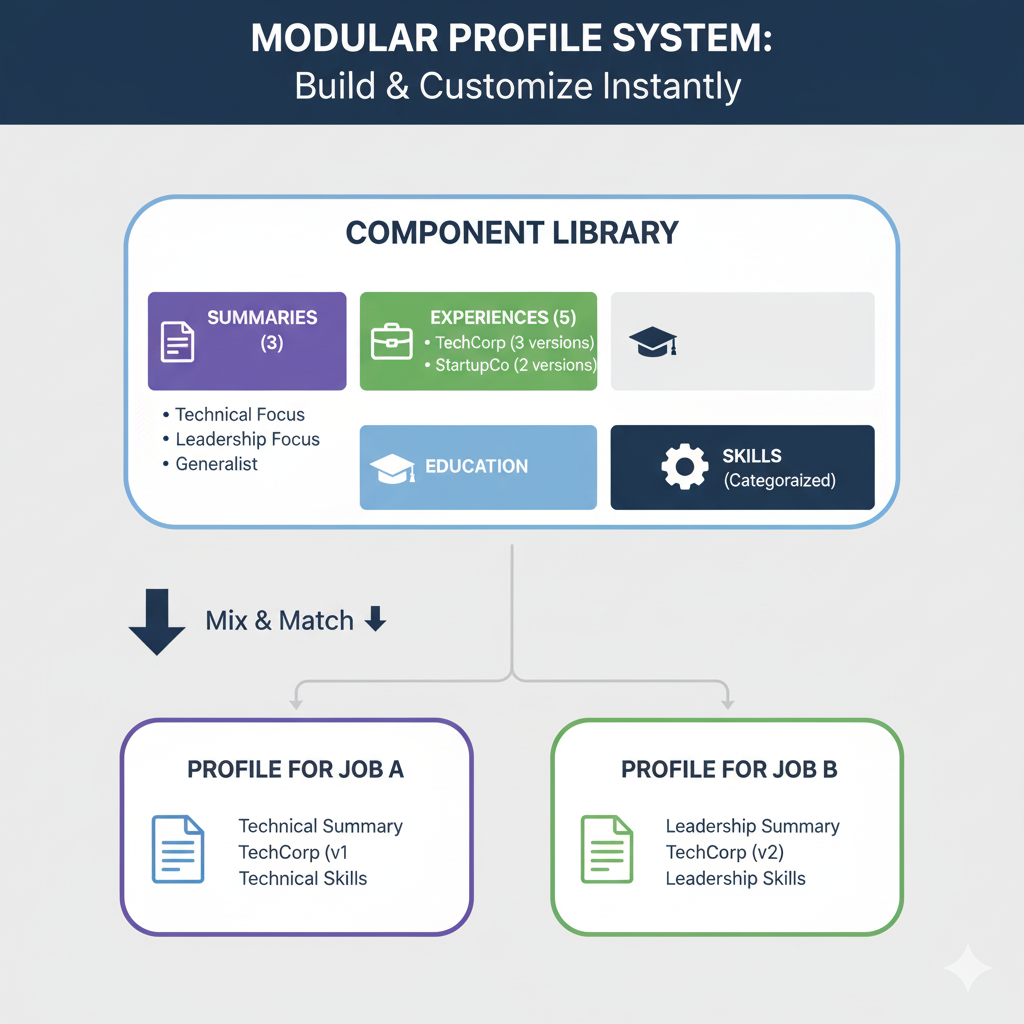
Step 4: Write a Personalized Cover Letter (Don't Skip This)
Myth: "Nobody reads cover letters."
Reality: For competitive roles, cover letters are the tiebreaker. When you're competing against 200 applicants, the cover letter is what makes you memorable.
The 3-Paragraph Formula
Paragraph 1: Why This Company Show you actually researched them. Mention:
- Specific product/service you admire
- Recent news (funding, launch, award)
- Company value that resonates with you
❌ "I'm excited to apply to your company" ✓ "I've been following TechCorp since your Series B announcement and I'm impressed by your commitment to remote-first culture, which aligns with my experience building distributed teams"
Paragraph 2: Why You're a Great Fit Connect YOUR experience to THEIR needs. Use the job description:
- Pick 2-3 top requirements
- Show specifically how you've done each one
- Use metrics/results
❌ "I have experience with Python and AWS" ✓ "In my current role, I've used Python and AWS to build a microservices architecture that handles 50M requests/day, directly applicable to the scalability challenges mentioned in your job description"
Paragraph 3: What You'll Bring End with forward momentum:
- What you're excited to accomplish
- How you'll add value quickly
- Clear call to action
✓ "I'd love to discuss how my experience scaling infrastructure could help TechCorp achieve your goal of 10x user growth this year. I'm available for a call this week at your convenience."
The AI Shortcut
Don't stare at a blank page. Use AI to generate a first draft:
- Input: Job description + your resume
- Output: Personalized cover letter in 30 seconds
- Your job: Edit to add personality and specific details
Tools like Hiir.me's cover letter generator do exactly this - create the first draft based on the actual job description and your profile, then you customize.
Step 5: Submit Application & Track Everything
This is where organization separates successful job seekers from frustrated ones.
What to Track for Each Application
Minimum viable tracking:
- Date applied
- Company name
- Job title
- Application method (company site, LinkedIn, email, etc.)
- Status (Applied → Phone Screen → Interview → Offer/Rejection)
Next level tracking:
- Profile link you sent (for trackable resumes)
- When they viewed your resume (if using trackable links)
- Follow-up dates (when to check in)
- Interview notes
- Questions they asked
- Your self-assessment of how it went
The Trackable Resume Link Advantage
Standard approach: Submit PDF resume, never know if anyone looked
Trackable approach: Send a unique profile link, see exactly when employers view it
Why this matters:
- You know if they're actually interested (viewed 3 times = they're considering you)
- You know when to follow up (they viewed yesterday = perfect time to send follow-up email)
- You stop wondering "did they even see it?"
How it works: Platforms like Hiir.me generate unique opportunity links. Each job gets its own link. When employers click, you get a notification with timestamp. Simple but powerful.
Follow-Up Strategy
Timeline:
- 1 week after applying: Brief email to hiring manager expressing continued interest
- 2 weeks after applying: Check application status if you have a contact
- After profile view: If they viewed your resume, follow up within 24 hours
Sample follow-up: "Hi [Hiring Manager],
I applied for the [Job Title] position last week and wanted to reiterate my strong interest. My experience with [specific relevant skill] aligns perfectly with [specific job requirement].
I'd love to discuss how I can contribute to [specific company initiative]. Are you available for a brief call this week?
Best, [Your Name]"
Step 6: Prepare for the Interview (Don't Wing It)
You got the interview! Now most people... completely wing it.
Big mistake. The candidates who prepare systematically get offers. The ones who don't, don't.
The Interview Prep System
1-2 weeks before interview:
Research the company deeply:
- Read last 10 blog posts
- Review product/service thoroughly
- Check recent news (Crunchbase, Google News)
- Find interviewers on LinkedIn (understand their background)
- Identify company challenges you can help solve
Prepare for likely questions:
Here's the secret: Interview questions aren't random. They're based on:
- Job description requirements
- Your resume (they'll ask about gaps, job changes, specific projects)
- Common questions for this role type
The systematic approach:
- Read the job description again
- List the top 5-7 requirements
- Prepare a STAR story (Situation, Task, Action, Result) for each requirement
- Practice out loud (not just in your head)
Example:
Requirement: Must handle ambiguity and changing priorities
Prepare a STAR Story:
- Situation: Project scope changed 3 times
- Task: Needed to keep the team motivated and aligned
- Action: Implemented flexible sprint planning, daily standups, and clear communication
- Result: Delivered on time despite shifting scope, team remained engaged
Use AI to generate practice questions: Tools like Hiir.me's Interview Prep feature generate 5-10 likely questions based on the actual job description and your resume. Practice answering, get AI feedback on your responses.
The night before:
- Prepare 5-7 questions to ask THEM (shows genuine interest)
- Review your STAR stories
- Prepare examples with metrics/numbers
- Get good sleep (seriously - tired you doesn't interview well)
Questions You Should Ask Them
Don't just ask generic questions. Ask things that show you've thought deeply about the role:
About the role:
- "What would success look like in the first 90 days?"
- "What's the biggest challenge the person in this role will face?"
- "How does this role fit into the team's goals for this quarter?"
About the team:
- "Can you tell me about the team I'd be working with?"
- "What's the collaboration style like?"
- "How does the team handle disagreements or competing priorities?"
About growth:
- "What does career progression look like for this role?"
- "Are there opportunities to learn [specific skill mentioned in job description]?"
Red flag detector:
- "Why is this position open?" (new role vs. someone left)
- "What's the biggest challenge your team is facing right now?"
- "What do people who struggle in this role have in common?"
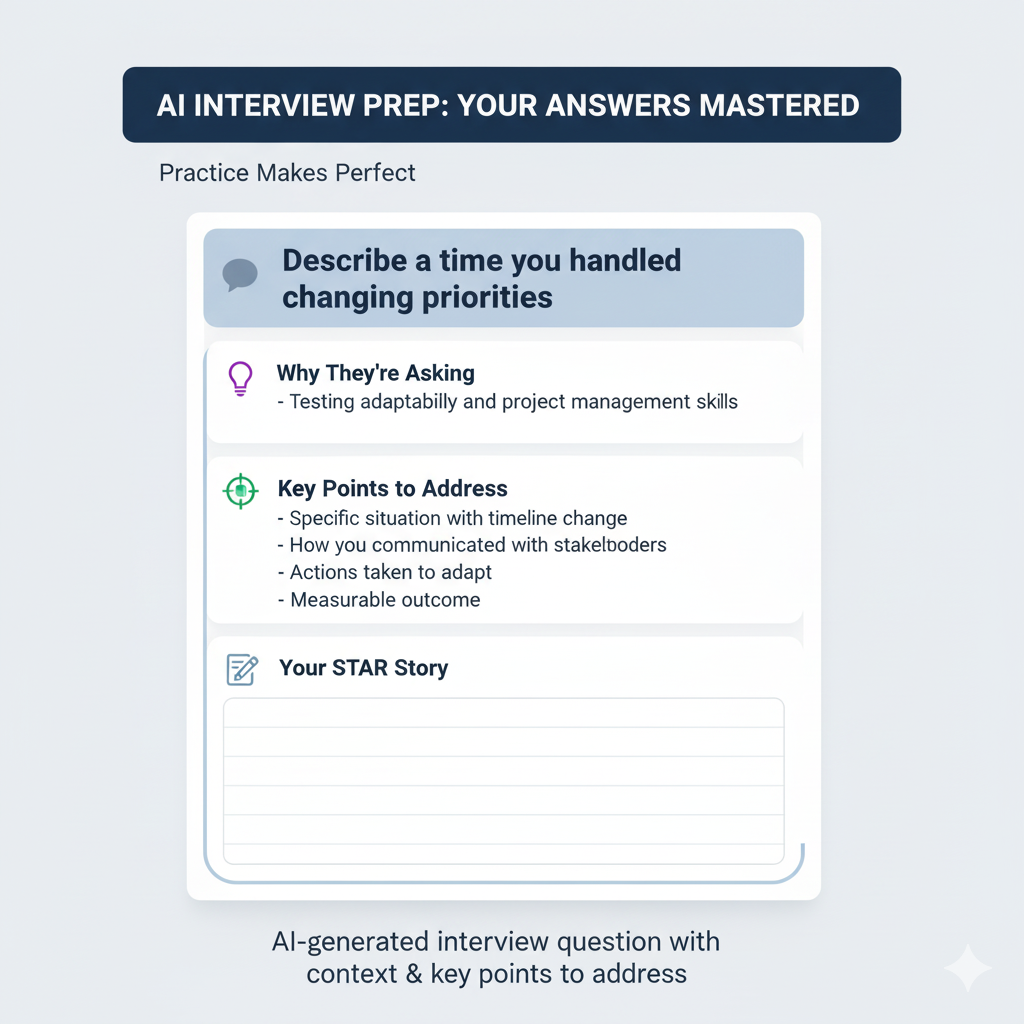
Step 7: Log the Interview & Learn from It
Here's what most people do after an interview: immediately forget everything and move on.
Here's what you should do: Brain dump everything while it's fresh, then analyze what to improve.
Immediately After the Interview (Within 30 Minutes)
Open a doc/notes app and write down:
- Every question they asked
- How you answered (roughly)
- What you wish you'd said differently
- Topics they seemed most interested in
- Questions you asked them
- Their responses
- Your gut feeling about how it went
- Any red flags you noticed
- Next steps they mentioned
Why this matters:
- If you advance to next round, you know exactly what they care about
- If you have another interview elsewhere, you can practice better answers
- Over time, you spot patterns in what you're being asked
The AI-Powered Analysis
Don't just journal - get feedback.
Use AI to analyze your interview performance:
- What you did well
- Where you can improve
- What to emphasize if you get a second round
- How to answer similar questions better next time
Hiir.me's Interview Journal does exactly this: brain dump your experience, AI organizes it and gives you specific feedback. No more guessing what went wrong.
Pattern Recognition Across Interviews
After 5-10 interviews, patterns emerge:
Common questions you're getting:
- "Tell me about a time you disagreed with a manager" (asked 4 times)
- "How do you handle tight deadlines?" (asked 6 times)
- "Describe your leadership style" (asked 3 times)
What this tells you: These are YOUR weak spots (or you're not answering them well). Prepare better answers.
Your performance trends:
- Interviews 1-3: Nervous, rambling answers
- Interviews 4-6: Getting better at STAR method
- Interviews 7+: Confident, concise answers
This self-awareness is how you actually improve instead of making the same mistakes 20 times.
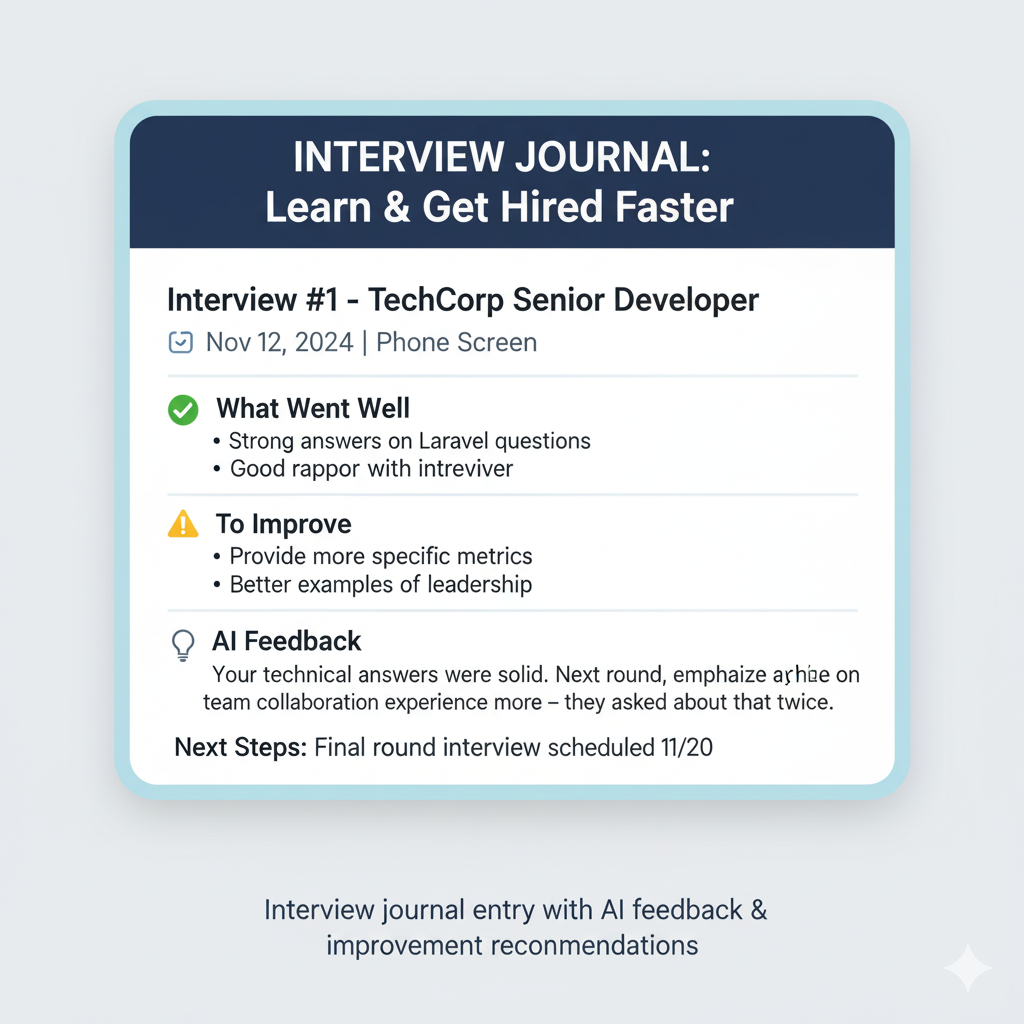
Why This System Works (And Volume Doesn't)
Let's compare two job seekers:
Job Seeker A (Random Approach):
- Applies to 100 jobs
- Same resume every time
- No cover letters
- Doesn't track anything
- Wings every interview
- Result: 2-3 interviews, 0 offers, burned out
Job Seeker B (Systematic Approach):
- Applies to 20 carefully selected jobs
- Tailors resume each time (using modular components - takes 10 min)
- Personalized cover letters (AI draft + edits - takes 15 min)
- Tracks everything including resume views
- Prepares for interviews systematically
- Learns from each interview
- Result: 3-6 interviews, 1-2 offers, confident and organized
Same effort. Better results.
Why? Because hiring managers can tell the difference between:
- Someone who spray-and-pray applies
- Someone who actually wants THEIR specific job
Your tailored application shows: "I researched your company, I understand your needs, I'm the solution."
The Tool That Makes This System Actually Sustainable
Here's the problem with job search systems: They require discipline and organization.
Most people start strong, then:
- Forget which resume version they sent where
- Lose track of what jobs they applied to
- Don't follow up because they forgot when they applied
- Can't prepare for interviews because they didn't save the job description
- Don't learn from interviews because they didn't take notes
The solution: Use tools that enforce the system for you.
What Hiir.me Does Differently
Instead of giving you isolated tools (a resume builder here, a tracker there), Hiir.me gives you one workflow for each job opportunity.
For every job you apply to:
Step 1: Save the opportunity (AI parses the job description) S
tep 2: Run ApplyScore to see your match percentage
Step 3: Build a tailored profile using your modular components
Step 4: Generate a personalized cover letter (AI draft)
Step 5: Get a trackable resume link, know when they view it
Step 6: Generate interview prep questions based on this job
Step 7: Log your interview and get AI feedback
Everything for this specific opportunity lives in one place. Nothing falls through the cracks.
Price: Try 3 complete workflows free. Upgrade to unlimited for $5/month.
Compare that to:
- JobScan: $50/month (only resume optimization)
- LinkedIn Premium: $30/month (mostly job listings)
- Resume builders: $20-30/month (just templates)
Hiir.me gives you the complete system for less than a coffee.
Common Objections (And Why They're Wrong)
"This takes too much time per application"
Let's do the math:
- Finding good job: 10 min (you were going to browse anyway)
- ApplyScore check: 2 min
- Customize resume (modular): 10 min
- Edit AI cover letter: 10 min
- Submit & track: 3 min
- Total: 35 minutes per application
Compare to:
- Spray-and-pray method: 5 min per application × 50 applications = 250 minutes
- Your method: 35 min per application × 15 applications = 525 minutes
Yes, it's more time per application. But you're getting 3-6 interviews instead of 1-2.
Worth it? Absolutely.
"I don't have time to learn a new system"
You don't have time NOT to. You're currently:
- Applying to jobs (wasting time if you're doing it randomly)
- Not getting interviews (wasting even more time)
- Feeling frustrated (wasting emotional energy)
Time investment:
- Learn this system: 1-2 hours
- Start seeing better results: Week 1
- Get your first interview from it: Week 2-3
"What if I'm desperate and need a job NOW?"
Then you ESPECIALLY need a system.
When you're desperate, you can't afford to waste applications on jobs where you have no chance. You need every application to count.
The systematic approach gets you interviews faster because your applications are better, not because you're sending more.
"This seems like overkill for entry-level jobs"
Entry-level jobs are the MOST competitive. You're competing against hundreds of other recent grads.
Standing out is everything. The new grad who sends a tailored application and shows up prepared to the interview gets the offer.
How to Start Using This System Today
Week 1: Set up your foundation
Day 1-2: Create your modular components
- Write 2-3 professional summary variations
- Write detailed descriptions for each past job (multiple angles)
- Organize your skills into categories
- Gather your education/certifications
Day 3-4: Set up your tracking system
- Choose your tool (spreadsheet, Notion, or Hiir.me)
- Create columns: Date Applied, Company, Job Title, Status, Follow-up Date
- Set up folders for saved job descriptions
Day 5-7: Find and save 5-10 quality opportunities
- Use the evaluation criteria from Step 1
- Save full job descriptions
- Research companies
- Identify hiring managers on LinkedIn
Week 2: Start applying systematically
Per application (35 minutes):
- Run ApplyScore check (2 min)
- Customize resume from components (10 min)
- Generate + edit cover letter (10 min)
- Submit + track (3 min)
- Schedule follow-up reminder (2 min)
Goal: 3-5 quality applications per week
Week 3-4: Interview prep mode
As interviews start coming in:
- Prepare using Step 6 system
- Log each interview using Step 7 system
- Adjust your approach based on feedback
The Bottom Line
You can keep doing what you're doing:
- Apply randomly to 100 jobs
- Get 2-3 interviews
- Wonder what's wrong with you
Or you can follow a proven system:
- Apply strategically to 20 jobs
- Get 5-8 interviews
- Choose between multiple offers
Same amount of work. Different approach. Better results.
The 7-step system isn't magic. It's just being systematic about what successful job seekers already do naturally.
The difference? You're doing it every time, for every application. Not just when you remember.
Ready to Stop Applying Randomly?
Try the complete 7-step system free:
✓ 3 complete workflows (all 7 steps)
✓ ApplyScore resume optimization
✓ Modular resume builder
✓ AI cover letter generator
✓ Trackable resume links
✓ Interview prep with AI feedback
✓ Interview journal
After 3 workflows, upgrade to unlimited for $5/month.
Stop wondering if your applications are good enough. Follow a system that works.
Frequently Asked Questions
Q: How long does it take to see results with this system? A: Most people get their first interview within 2-3 weeks of starting. But it depends on your field and location. The system improves your odds, but you still need to put in the reps.
Q: Do I really need to do all 7 steps for every job? A: Yes, if you want the best results. Skipping steps (especially customization and interview prep) significantly reduces your chances.
Q: What if I'm applying to 100+ jobs because I'm desperate? A: Quality over quantity, especially when desperate. 10 great applications outperform 100 mediocre ones. You can't afford to waste applications when you need results fast.
Q: Can I use this system for remote jobs, contract work, or freelance? A: Absolutely. The principles are the same - understand what they need, show you're the solution, prepare systematically.
Q: How does this compare to just hiring a career coach? A: Career coaches charge $100-500/hour and still teach you these same principles. This system gives you the framework + tools for $0-5/month.
Q: What if I'm changing careers and don't have direct experience? A: The system still works - you'll emphasize transferable skills in Steps 2-3 and address the career change directly in your cover letter (Step 4).
Related Articles
- [What is an ATS? Why 75% of Resumes Get Rejected] - Understand the first major hurdle in your job search
- [How to Tailor Your Resume Without Starting From Scratch] - Master the modular approach (Step 3)
Stop applying randomly. Start following a system that actually works.
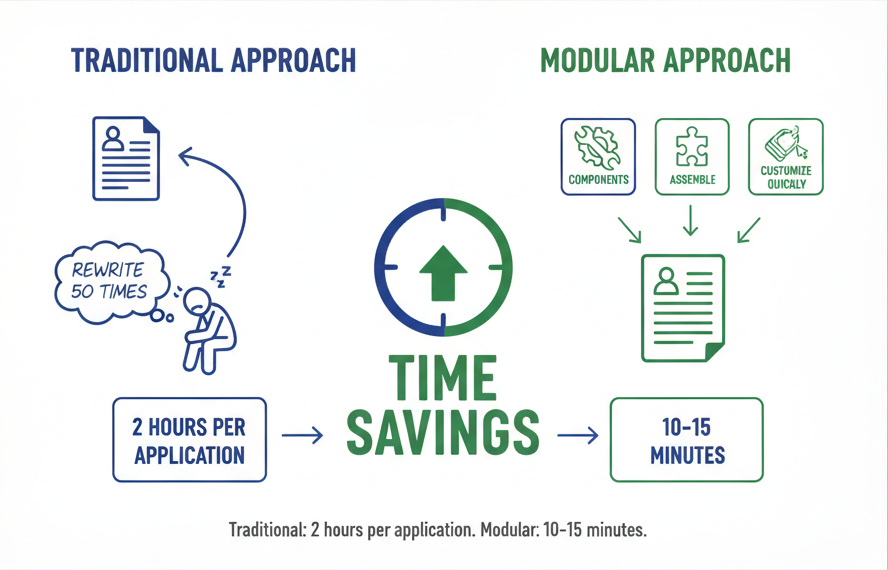 Start Your Free Workflow →
Start Your Free Workflow →